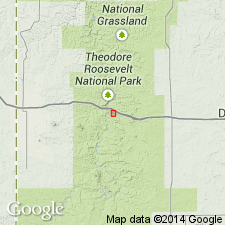
- Usage in publication:
-
- Medora Member
- Modifications:
-
- Named
- Dominant lithology:
-
- Sand
- AAPG geologic province:
-
- Williston basin
Summary:
Named as a member of Tongue River Formation of Fort Union Group for town of Medora, Billings Co, ND in Williston basin. Type section defined at exposure in the NW1/4 sec 26, T140N, R102W, Billings Co. Occurs about 80 ft below the top of Tongue River Formation. Extends for at least tens of mi north and south of Medora. Forms steep cliff faces with many closely spaced vertical rills. Consists of a tabular sand body 15-25 ft thick with a characteristic somber brownish-gray color. Although it is a member of Tongue River Formation, Medora more closely resembles the sand bodies of Sentinel Butte Formation; it is much less friable than all of the other types of sand bodies in Tongue River Formation. Underlying and overlying units [probably unnamed parts of Tongue River] not indicated. Base said to be a sharp scoured surface. Top varies from sharp to gradational. Cross section. Of Paleocene age. Was probably a point-bar deposit.
Source: GNU records (USGS DDS-6; Denver GNULEX).
For more information, please contact Nancy Stamm, Geologic Names Committee Secretary.
Asterisk (*) indicates published by U.S. Geological Survey authors.
"No current usage" (†) implies that a name has been abandoned or has fallen into disuse. Former usage and, if known, replacement name given in parentheses ( ).
Slash (/) indicates name conflicts with nomenclatural guidelines (CSN, 1933; ACSN, 1961, 1970; NACSN, 1983, 2005, 2021). May be explained within brackets ([ ]).

